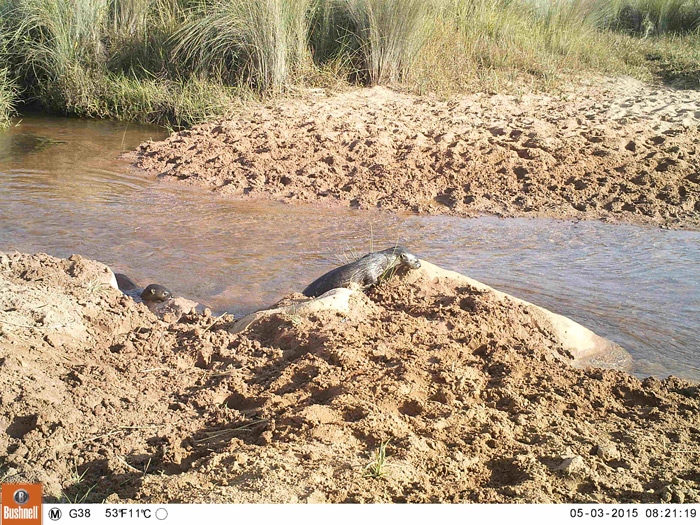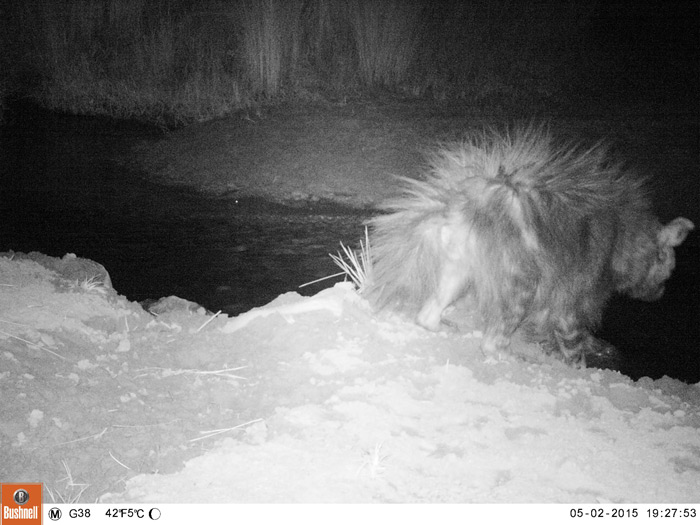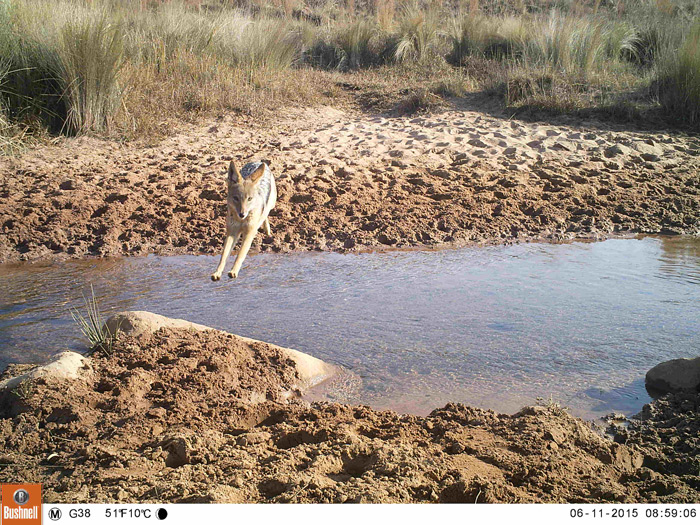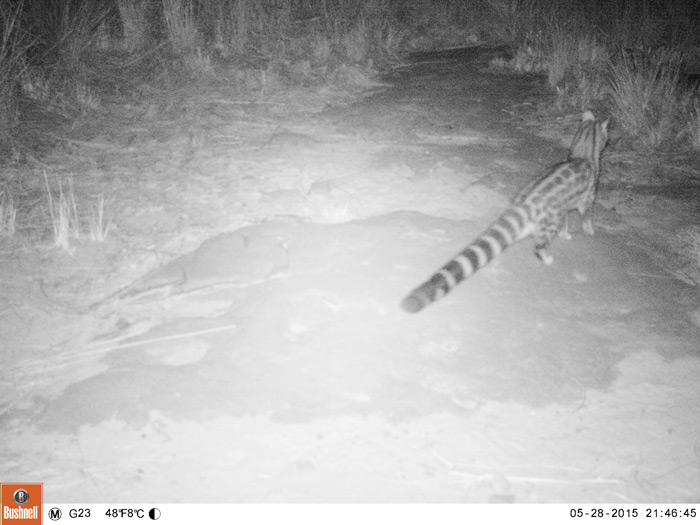Despite years of biological, ecological, and behavioural research, our knowledge and understanding of mesocarnivores – small to medium-sized carnivores – and their dynamic interactions is still limited. These little predators – mongooses, caracal, honey badgers and the like – are important members of terrestrial ecosystems contributing to seed dispersal, disease ecology and the regulation of rodent and insect populations. The nocturnal habits of several of these species make them a challenge to study. Written by: Andrea Webster, Centre for Wildlife Management, University of Pretoria

Many aspects of our lives have been influenced by technology, and the sciences are no different. Fitting animals with satellite tracking collars or putting up camera traps allows us to monitor animals and their movements without our physical presence interfering with their daily routines. Like most technological things, camera trapping can be tricky if things don’t go according to plan. There’s a fine line between positioning one’s traps to ensure they record the data you are looking for and ensuring they are safe from wandering warthogs looking for a scratching post or curious baboons.
When we began our three-and-a-half month survey of mesocarnivores on Telperion Nature Reserve, a privately owned and managed property in Mpumalanga, in April 2015, we had little idea of the diverse range of mesocarnivores we would find. The undulating grasslands of the 7,350-ha reserve are interspersed with rocky kopjes and spectacular red sandstone cliffs along the Wilge River, which flows through the reserve for about 20km. Smaller tributaries run through the reserve, creating wetlands and reed beds that provide nesting sites for water birds and a much-needed resource to the many antelope and mammal species on the property in the dry season.
Competition is a common phenomenon in natural systems and influences species distribution patterns and diversity in an area. Because organisms don’t exist in isolation, animals must adopt a survival strategy or combination of strategies that allows them to obtain the key elements of survival – food, water, and shelter – while simultaneously avoiding or limiting interactions with competitors and larger predators that may make a meal of them. Using different resources, time or space are some of the ways that animals survive in a competitive environment.
The obvious differences between the open stretches of grassland and the dense, tangled vegetation hemmed in by rocky ledges near the river, together with the differences in resource availability in each vegetation type, offered a unique opportunity to investigate species composition on the property and gain insight into the survival strategies used by different mesocarnivore species occupying each vegetation type.
In our three and a half months of camera trapping, we identified 14 species of mesocarnivores – black-backed jackal, meerkat, slender, yellow and water mongooses, large-spotted genet, caracal, serval, striped pole cat, black-footed cat, honey badger, aardwolf, spotted necked otter and Cape clawless otter.


Two large predator species, leopard and brown hyena, were also detected on the property, making for a wonderfully diverse group of different creatures in such a small area. Aardvark, porcupine, bush pig and cane rat were some of the other species we identified during the study. Contrary to our predictions, many of the species detected utilised grassland more than the concentrated resource riparian areas.



Our findings showed that despite having similar diets and being active at more or less the same times of day, slender mongoose and yellow mongoose avoid each other by using different attributes within the same vegetation type. While yellow mongooses used only grassland areas, slender mongoose divided their time between the riparian areas and the rocky outcrops of the kopjes to forage for food, thus avoiding competition. Black-backed jackal were the species most often detected during the study and were active throughout most of the day and night, taking time to rest during the heat of the day. They were seldom observed near the river, appearing to favour the use of the riparian area as a corridor. Rusty-spotted genets were active throughout the night and favoured areas around the river the most. When venturing into grassland areas, they kept to the rocky outcrops or wooded areas that provided them with some means of escape should they encounter anything that may consider them a meal. These species used both time and space to limit interactions and, therefore, competition for resources.


Genet, water mongoose, serval, and jackal were active at lower temperatures of around 5ºC, while members of the mongoose family were active at higher temperatures (around 22ºC) during the heat of the day. Jackals were active over the widest range of temperatures from -10ºC to 40ºC. The majority of nocturnal species detected were most active during the phases of the new moon and waxing crescent.

Our study has contributed new details and insights towards understanding the diverse, abundant, and adaptable creatures that are mesocarnivores. Now we know where and when to find them, we can examine further aspects of their behaviour, ecology, interactions with other species, and their role in a changing natural environment.
 Keen to find Africa’s small and large carnivores? Check out our safari options – find a ready-made safari or ask us to build one just for you.
Keen to find Africa’s small and large carnivores? Check out our safari options – find a ready-made safari or ask us to build one just for you.
To comment on this story: Login (or sign up) to our app here - it's a troll-free safe place 🙂.![]()
HOW TO GET THE MOST OUT OF AFRICA GEOGRAPHIC:
- Travel with us. Travel in Africa is about knowing when and where to go, and with whom. A few weeks too early / late and a few kilometres off course and you could miss the greatest show on Earth. And wouldn’t that be a pity? Browse our ready-made packages or answer a few questions to start planning your dream safari.
- Subscribe to our FREE newsletter / download our FREE app to enjoy the following benefits.
- Plan your safaris in remote parks protected by African Parks via our sister company https://ukuri.travel/ - safari camps for responsible travellers






